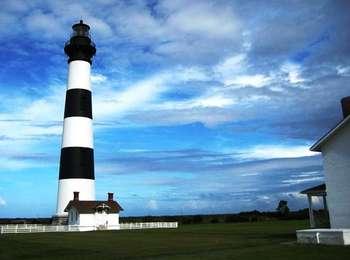Last updated: November 7, 2021
Place
Bodie Island Lighthouse

Standing 156-feet tall, the current Bodie Island Lighthouse is actually the third lighthouse along this stretch of the Outer Banks to warn and guide ships.
The Bodie Island Lighthouse has a distinctive daymark pattern of horizontal, alternating black and white stripes.
The Bodie Island Lighthouse is open to climbing April-October. Tickets must be purchased the day-of your visit on www.recreation.gov
Historical Lighthouses
In 1837, the federal government sent Lieutenant Napoleon L. Coste of the revenue cutter Campbell to examine the coastline for potential lighthouse sites that would supplement the existing one at Cape Hatteras. Coste determined that southbound ships were in great need of a beacon on or near Bodie Island by which they could fix their position for navigating the dangerous cape. He punctuated his recommendation with the statement that "more vessels are lost there than on any other part of our coast."
Congress responded with an appropriation for a lighthouse that same year, but complications over purchasing the necessary land delayed construction until 1847. This was but the first of many problems. Though the skillful Francis Gibbons was contracted as engineer, the project's overseer was a former Customs official named Thomas Blount, who unfortunately, had no lighthouse experience at all. This proved disastrous when Blount ordered an unsupported brick foundation laid, despite Gibbons' recommendations to the contrary. As a result, the 54-foot tower began to lean within two years after completion. Numerous expensive repairs failed to rectify the problem and the lighthouse had to be abandoned in 1859.
The second lighthouse fared little better than its wobbly predecessor. Though funded, contracted, and completed in prompt fashion at a nearby site in 1859, it soon succumbed to an unforeseen danger: the American Civil War. Fearing that the 80-foot tower would be used by Union forces, retreating Confederate troops blew it up in 1861.
Current Lighthouse
After the American Civil War, the coast near Bodie Island remained dark for several years while a replacement tower was considered by the Lighthouse Board. Though the Board was disposed against the idea, numerous petitions came in from concerned ship captains and, finally, it decided in favor of a third Bodie Island Lighthouse. Still, it was not until 1871 that construction began. The first two Bodie Island Lights had been located south of Oregon Inlet, actually on Pea Island. The new 15-acre site, purchased by the government for $150.00 from John Etheridge, was north of the inlet.
Work crews, equipment, and materials from the recent lighthouse project at Cape Hatteras were used to build necessary loading docks, dwellings, and facilities. Government contracts brought bricks and stone from Baltimore firms, ironwork from a New York foundry, and granite from Mount Airy, North Carolina. Construction of the tower proceeded smoothly and it first exhibited its light, magnified by a powerful first-order Fresnel lens, on October 1, 1872.
Early problems with flocks of geese crashing into the lens and improper grounding for electrical storms were quickly rectified with screening for the lantern and a lightning rod for the tower. There have been few other difficulties with the lighthouse itself since its completion.
Fresnel Lens
Mariners have depended on lights for navigation for over 2,000 years. As maritime travel and commerce increased, so did the quantity and quality of navigational lights. Brick and metal lighthouses replaced wooden platforms. Brighter burning oil lamps took the place of simple wood or coal fires. Parabolic or spherical reflectors were added to concentrate the lights and increase visibility. In 1822, one of the greatest improvements in lighthouse technology came when Augustin Jean Fresnel, a French physicist, introduced a new lens design.
Fresnel's lens resembles a giant beehive with a system of multi-faceted glass prisms mounted in a brass framework. The prisms refract (bend) light and magnify it, thereby taking rays of light that would normally scatter in all directions and focusing them into a single beam. Because of this design, a Fresnel lens is much more efficient than traditional light sources. Tests show that an open flame loses nearly 97% of its light. A light with a reflector placed behind it loses 60-80% of its light. With a Fresnel lens, only a maximum of 20% of its light is lost! Before this, the brightest lighthouse beams could reach 8 to 12 miles away. The light from a Fresnel lens could shine all the way to the horizon, which is more than 20 miles away!
Prior to the Fresnel lens, most lighthouses had only solid, steady lights. This made it difficult to distinguish one light from another, often causing confusion and dangerous conditions for passing ships. But the Fresnel lens could produce an almost unlimited combination of patterns, depending on the number of installed flash panels and the speed that the lens revolved.
Signaling Ships
The Bodie Island Lighthouse has a first-order Fresnel lens with an interesting flash pattern that reaches over 20 miles out to sea. The light is on for 2.5 seconds, off for 2.5 seconds, on for 2.5 seconds, and then off for 22.5 seconds. Originally run on various types of oil, the light was electrified in 1932, phasing out the need for on-site keepers.
During the day, the Bodie Island Lighthouse is distinguished from other lighthouses along the coast by the horizontal black and white stripes. This paint pattern is known as a daymark.
